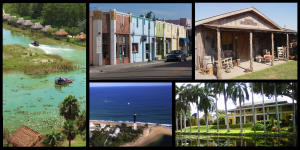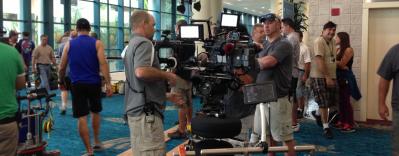@visitlauderdale
Your browser is not supported for this experience.
We recommend using Chrome, Firefox, Edge, or Safari.
Film & Video Production
The Business of Making Movies
Have you ever watched any of these movies?
Where the Boys Are (1960)
There’s Something About Mary (1998)
Analyze This (1999)
Rock of Ages (2005)
Marley & Me (2008)
Iron Man 3 (2013)
Baywatch (2017)
Waves (2019)
Can you identify what these feature films have in common?
If you guessed that all of them were shot, at least in part, in Greater Fort Lauderdale (the “marketing” name for Broward County), you would be right! These film productions and many, many more were shot here! For many years, we have been a key location for film and continue to be more than ever a priority destination for film projects in the industry. And not only feature films, Greater Fort Lauderdale has been the setting for TV productions, as well! Perhaps you have seen or heard about some of these:
Jack & Jill, The Sopranos, Corazon Valiente, El Rostro de la Vengaza, Dexter, The Glades, Graceland, VH1's Tough Love, Magic City, Bar Rescue, Hotel Impossible, Gator Boys, Kenny Chesney's video for "Come over"
Even though in the final edit you may think that they were shot somewhere else, all the above productions had some scenes shot around here! Greater Fort Lauderdale can serve as the ideal backdrop to the skillful director. Watch this: https://youtu.be/k3EtmSPkyBw
Even though we have not attracted the number or size of productions that places like Vancouver, Canada or the State of Georgia have, the economic impact of the on-location film industry to Greater Fort Lauderdale is not to be underestimated: more than $800 million since 2009. In roughly the same period, Greater Fort Lauderdale has hosted more than 800 productions from feature films to high impact TV series, telenovelas, documentaries, independent projects, commercials, music videos and still shoots. These types of investments have direct and indirect impacts on our community, when they support our local crews, and other vendors (catering, carpenters, hotels, makeup and scenic artists, security, transportation) that contribute to the project.
A Little Bit of History
 The Broward Film and Television commission was formed in 1982 as a full-service coordination office for filming in Broward County, that is to help productions make all the arrangements necessary to shoot in our County. In April 2010 the Film Commission was transitioned to the Greater Fort Lauderdale Convention & Visitors Bureau (sunny.org) as the Greater Fort Lauderdale/Broward Office of Film & Entertainment (OFE) increasing overall growth by 60%. The move allowed for the formalized marketing (promote and showcase) of our destination as a key "location" to the production/film and entertainment industry, with its multi-faceted locales and our production-friendly hotels. The Greater Fort Lauderdale OFE also works very hard to ensure that members of the film industry experience a smooth, easy, friendly and fun journey while they are here.
The Broward Film and Television commission was formed in 1982 as a full-service coordination office for filming in Broward County, that is to help productions make all the arrangements necessary to shoot in our County. In April 2010 the Film Commission was transitioned to the Greater Fort Lauderdale Convention & Visitors Bureau (sunny.org) as the Greater Fort Lauderdale/Broward Office of Film & Entertainment (OFE) increasing overall growth by 60%. The move allowed for the formalized marketing (promote and showcase) of our destination as a key "location" to the production/film and entertainment industry, with its multi-faceted locales and our production-friendly hotels. The Greater Fort Lauderdale OFE also works very hard to ensure that members of the film industry experience a smooth, easy, friendly and fun journey while they are here.
The Process
As you can imagine, a production crew doesn’t just show up at a designated spot and start shooting. There is a long process to that point. It starts with the Development of the idea, the concept or the story. Once the project has been approved and there is funding for it, Pre-Production starts. As you would expect, after Pre-production the actual Production takes place. Finally, Post-Production will edit and finalize the work, and make it ready for release.
Development
Imagine you are a producer: whether you have selected a story and have a screenplay in-hand, or you work for a client such as a musical act or a media agency that is advertising a product or an event. If you are working on a film (short or feature length), the idea may come from a book, play, another film, true story, video game, comic book, graphic novel, or an original idea, etc. If you are working on feature films for Hollywood distributors, be ready for executives to adopt a hard-headed business approach. More often than not, films do not manage to recover the costs, so those funding the project will want to hear a “pitch” that sells them on the concept: you need to be ready to explain things such as the film genre, the target audience and assumed audience, the historical success of similar films, the actors who might appear in the film, and potential directors and other high profile crew. All these factors imply a certain appeal of the film to a possible audience and more security for those who are investing in it.
After identifying a theme or underlying message, you will work with a writer or writers on a few preparatory steps: You will need to write a synopsis, an outline (which breaks the story down into scenes), and a treatment (a longer description of the story, its mood, and characters). At this point, if you did not start with a screenplay, you will work with a screenwriter to write (and re-write) one. Re-writes are very common. They follow the producer’s (and the production company or studio) to improve dramatization, clarity, structure, characters, dialogue, and overall style. (Also, to suit the location, more on this later).
If you had not done so before, at this point you will work with the screenwriter to prepare a film pitch, or treatment, and present it to potential financiers or to your client. If things continue moving forward, as a producer you now will pitch the film to actors, directors and others to sell them and "attach" them to the project. Most feature films never move beyond this stage. If you ever heard of the cult classic “The Princess Bride” (1987) directed by Rob Reiner, it was one of those films that was stuck in “development” for years, until a powerful director/producer like Reiner was able to carry the movie to completion. Commercial and video shoots usually start with a budget in consideration and, therefore, are somewhat pre-approved from the start.
Analogous to most any business venture, financing of a feature film project deals with the assets that are required to fund the film making and liabilities incurred during the film making over the time period from early development through release. It requires the management of profits and losses during and after distribution under conditions of uncertainty and risk. Film finance aims to manage risk levels and expected rate of return for the project. As a producer, you will need to be familiar with these concepts as they relate to the project, and to those who have provided the budget to produce it.
At this point you haven’t shot the first second of film or video, so you can see that a lot of work goes into this type of work, particularly for the producer. Once you get everyone to agree on some of the issue above and a deal has been reached, the film may proceed into the pre-production period.
Pre-production
Your work continues in pre-production (or simply “pre”), during which every step of creating the film is carefully designed and planned. Everything is choreographed and very little is left to chance.
 A storyboard (simple drawings representing scenes and sequences of the film) helps you and the director to visualize completed work. Here you will create a production budget, planning for all expenditures related to the project (production, post-production, distribution).
A storyboard (simple drawings representing scenes and sequences of the film) helps you and the director to visualize completed work. Here you will create a production budget, planning for all expenditures related to the project (production, post-production, distribution).
The nature of the production, and the budget, will determine the size and type of crew used during shooting. If you have a big budget, you can afford cast and crew of hundreds; if what you have is a low-budget, well, as a producer you will need to be smart to get all you need out of fewer people.
These are typical crew positions:
Producer: many responsibilities.
Director: responsible for the storytelling, creative decisions and acting of on-camera talent.
Assistant director (AD): supports the director, manages the shooting schedule and logistics of the production, among other tasks.
Storyboard artist: turns screenplay (script) into images for visualization.
Unit production manager: manages the production budget and production schedule.
Location manager: finds and manages film locations. This position may fall to the Producer, depending on the size of the production. (Here’s where the Greater Fort Lauderdale team comes into play. We can be a great help from here and through actual production).
Art Director/Production designer: one who creates the visual conception of the film (the look and feel).
Costume designer: responsible for the clothing for the characters. This applies to all productions, not just period, fantasy or sci-fi/futuristic shoots.
Makeup and hair designer: responsible for the look of on-camera talent.
Casting director: finds/auditions talent. This may also fall to the Producer.
Director of photography (DP): the head of the photography and cinematography of the entire shoot. Responsible for the cameras and lighting. This could mean several teams.
Sound mixer: head of the sound department during the production. They record and mix the audio on set – dialogue, presence and sound effects in mono and ambience in stereo. Depending on the budget, as a Producer you will decide if you can hire one or multiple people for this responsibility, but it is crucial if there is dialogue (talent speaking on camera!)
Production
Here is where the idea comes to life, piece by piece, scene by scene, line by line. Although, as you may know, no work is shot in order. With the script, the storyboards and the planning that happened in “pre”, the schedule of how the shooting goes works as a function of location, available talent, weather, and other needs; not based on the order in which everything will flow once it’s edited.
A typical day shooting begins with the crew arriving on the set/location by their call time. Actors usually have their own separate call times. Since set construction, dressing and lighting can take many hours or even days, they are often set up in advance.
The grip, electric and production design crews are typically a step ahead of the camera and sound departments: for efficiency's sake, while a scene is being filmed, they are already preparing the next one.
While the crew prepares their equipment, the actors do their costumes and attend the hair and make-up departments. The actors rehearse the script and blocking with the director, and the camera and sound crews rehearse with them and make final tweaks. Finally, the action is shot in as many takes as the director wishes. Most American productions follow a specific procedure and if this were a screenplay it would look something like this:
EXT. HOLLYWOOD BANDSHELL – DAY
A movie crew is ready to begin a long day of shooting beach scenes.
The Director has coached the talent they are moving to their places.
ASSISTANT DIRECTOR
(yelling)
PLACES EVERYONE!!! QUIET ON THE SET!
Everyone on site freezes as if a spell had descended on Hollywood Beach.
ASSISTANT DIRECTOR
(yelling)
ROLL SOUND!
A voice comes from behind the AD and the Directors.
SOUND MIXER (OFF-SCREEN)
(distant yelling)
ROLLING!
ASSISTANT DIRECTOR
(yelling)
CAMERA!!!!
Another voice, this time from behind the camera answers.
CAMERA OPERATOR
(yelling)
SPEED!!!
ASSISTANT DIRECTOR
(yelling)
MARKER!
A woman, with several sharpies on her, one behind the ear, one tucked into her wristband, two in her back pocket, steps in front of the camera with a contraption called a “SLATE”. On it several marks indicate things like scene and take, which as of this moment is number one.
PRODUCTION ASSISTANT
(yelling)
THE GREATER FORT LAUDERDALE MOVIE LESSON…
SCENE 22. TAKE 1.
When done the PA slams the top part of the “slate” onto the rest of the board, while holding it steady in front of the camera, then promptly darts out of the way.
DIRECTOR
(yelling)
AND ACTION BACKGROUND
Bicycles cut in front of the camera in both directions, there are joggers and pedestrians. Tourists approach a beach taco stand. In the distance a yacht sails behind the shell.
DIRECTOR
(yelling)
CUT! … Excellent!
ASSISTANT DIRECTOR
(to the Camera Op)
FOCUS
CAMERA OPERATOR
CHECKED!
DIRECTOR
(to the AD)
That was good, but I would like to run it a few more times…
ASSISTANT DIRECTOR
(yelling)
ALL RIGHT EVERYBODY… FROM THE TOP…BACK TO YOUR…
CUT TO:
CLOSE UP ON PRODUCER TURNING TOWARDS A FOLDER FULL OF PAPERS
In the producer’s mind the words trail off, as she turns towards the budget and the schedule…
DIRECTOR
(yelling)
AAAND… ACTION!
A band begins playing in the shell, although mid-song.
DIRECTOR
(yelling)
AND ACTION BACKGROUND!
DIRECTOR
CUT TO:
CLOSE UP ON PRODUCER TURNING TOWARDS A FOLDER FULL OF PAPERS
In the producer’s mind the words trail off, as she turns towards the budget and the schedule…
That “scene” will repeat itself many times over each shot. At the end of every day, the director, producer(s) and AD approve the next day's shooting schedule. “Call sheets” are distributed to the cast and crew to tell them when and where to turn up the next shooting day. Later, the director, producer, other department heads, and, sometimes, the cast, may gather to watch that day or yesterday's footage, called dailies, and review their work. The days are long, very long, often lasting 14 or 18 hours.
No matter what, as long as the production is here in Greater Fort Lauderdale and until they scream “THAT’S A WRAP!”, we can help them bring the vision to life.
Post-production
 Sometimes simply called “post”, here the video/film is assembled by the film editor (or a group of editors, again depending on the size of the project). The shot film material is edited down. No production uses ALL the material that was shot. In fact, the process of editing is not only about putting the right things in the right places; sometimes it is about getting rid of things at the right times. The production sound (dialogue) is also edited; music tracks and songs are composed and recorded, or if using existing songs those get added; sound effects are designed and recorded. Any computer-graphic visual effects are digitally added by an artist, sometimes the editor can do that: things like changing the color of the sky in a certain scene, or adding credits at the beginning or at the end, “painting” over a detail that should not have been there, etc.
Sometimes simply called “post”, here the video/film is assembled by the film editor (or a group of editors, again depending on the size of the project). The shot film material is edited down. No production uses ALL the material that was shot. In fact, the process of editing is not only about putting the right things in the right places; sometimes it is about getting rid of things at the right times. The production sound (dialogue) is also edited; music tracks and songs are composed and recorded, or if using existing songs those get added; sound effects are designed and recorded. Any computer-graphic visual effects are digitally added by an artist, sometimes the editor can do that: things like changing the color of the sky in a certain scene, or adding credits at the beginning or at the end, “painting” over a detail that should not have been there, etc.
After all that work, the edited work goes through several rounds of screenings for the Director, Producer(s) and other key personnel in the production. Final changes result from the screenings, until a FINAL version is ready for release.
From there it will go to where you, the Producer, have decided: for theater distribution, for TV (network or cable), for VOD (YouTube or subscription services).
The Glamour
 One of the most important ways that artists, creators and filmmakers get exposure for their work IS by participating and “competing” in film festivals of different kinds. In Greater Fort Lauderdale our support for the film industry goes beyond the assistance we provide to productions while on location, we also are home to a series of International and renowned film festivals.
One of the most important ways that artists, creators and filmmakers get exposure for their work IS by participating and “competing” in film festivals of different kinds. In Greater Fort Lauderdale our support for the film industry goes beyond the assistance we provide to productions while on location, we also are home to a series of International and renowned film festivals.
Here’s a sampling of some of the best:
Fort Lauderdale International Film Festival
Since 1986, the Broward County Film Society has shared the beauty of independent cinema with South Florida through the Fort Lauderdale International Film Festival. More than 30 years later, The Film Society has leveraged the success of FLIFF to establish itself as one of five Major Cultural Institutions of Broward County.

The Miami Gay & Lesbian Film Festival started in 1998; the Fort Lauderdale Gay & Lesbian Film Festival in 2008. Both were brought together under one brand: OUTshine LGBT+ Film Festival - underscoring our broad appeal and dynamic multi-cultural location. Critically and internationally acclaimed, it serves as a platform for numerous premiers and is the largest LGBT+ cultural arts event in South Florida.
Southern Circuit Independent Film Festival
Southern Circuit brings the best of new independent film to communities across the South. Audiences have seen over 300 films in more than 100 Southern communities. South Arts (the organization behind the Festival) works collaboratively with Screening Partners to expand their programming, provide audiences with the opportunity to meet filmmakers and learn about the art of filmmaking, and encourage community engagement using film as a conduit for discussions about social and community issues. Invited filmmakers are paid to screen their work and engage with new audiences, travel expenses covered!
 The Schools
The Schools
If you have read this far, we can probably guess that you are already interested in this field. Luckily, here in Broward there are some world-class institutions to get your training and education started. Visit these two programs from some local organizations:
The Art Institute Fort Lauderdale Digital Filmmaking and Video Production
Broward College’s Film Production Technology
Career Corner
Storyboard Artist
A storyboard artist creates simple, yet complete visual representations of a concept, an idea or a story. Whether they will be used for a music video, a advertisement or commercial, or for a film, storyboards help those with the idea to bring the concept to life and get organized to make it happen. And just because the drawings are “simple” does not mean they are “lower quality”. Some magnificent illustrators are storyboard artists.
These drawings do tend to be low on details, but they provide just enough to tell the whole story, evaluate how compelling it is, how it flows and how it could resonate with audiences. Many storyboard artists work “freehand” even if it on their computers, although all you need is a marker and a piece of paper.
Sometimes writers/producers/directors will use storyboards to “pitch” the idea to those who can fund it. Sometimes it will be to explain to the client the creative direction for the ad. Sometimes a team of creators will use the storyboards to make their story better.
Lesson Questions:
1. Name the four (4) stages of the production process.
2. In your own words, describe each stage of the production process.
3. Name some of the types of productions that GFL can support, here on-location.
4. Why is supporting film productions important for GFL/Broward County?
5. Name a way for creators to publicize their films.
6. Name three (3) film festivals that take place in GFL.

